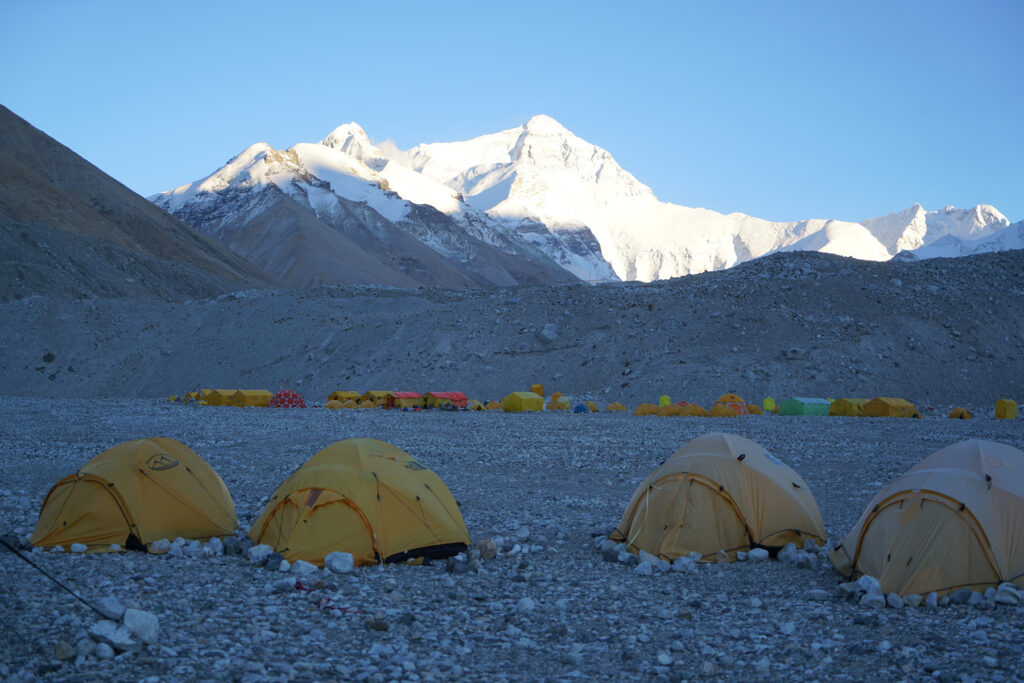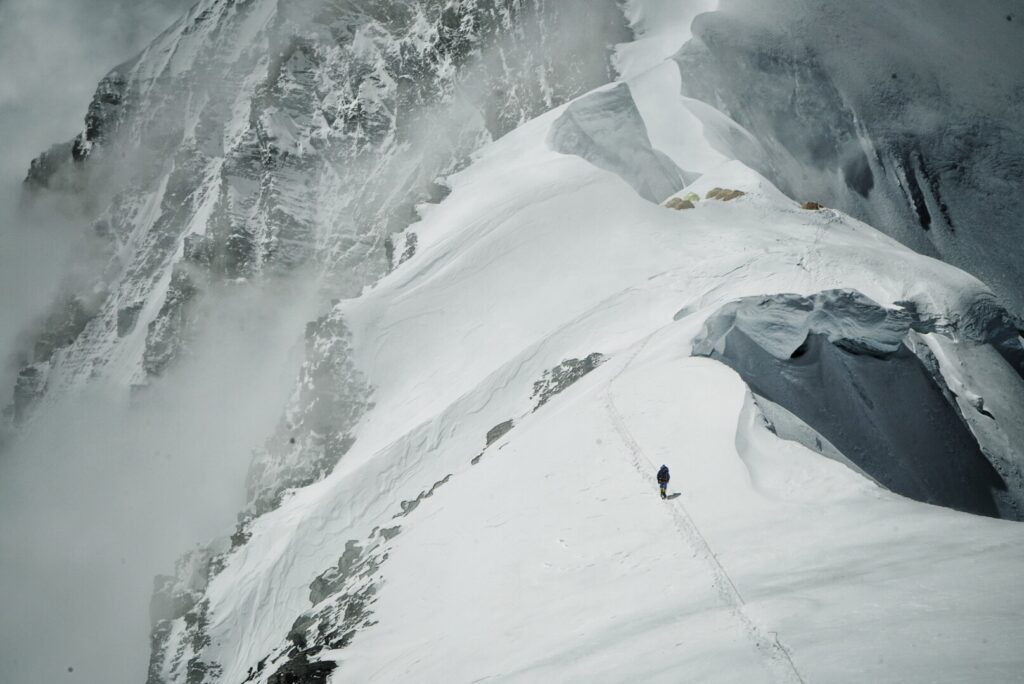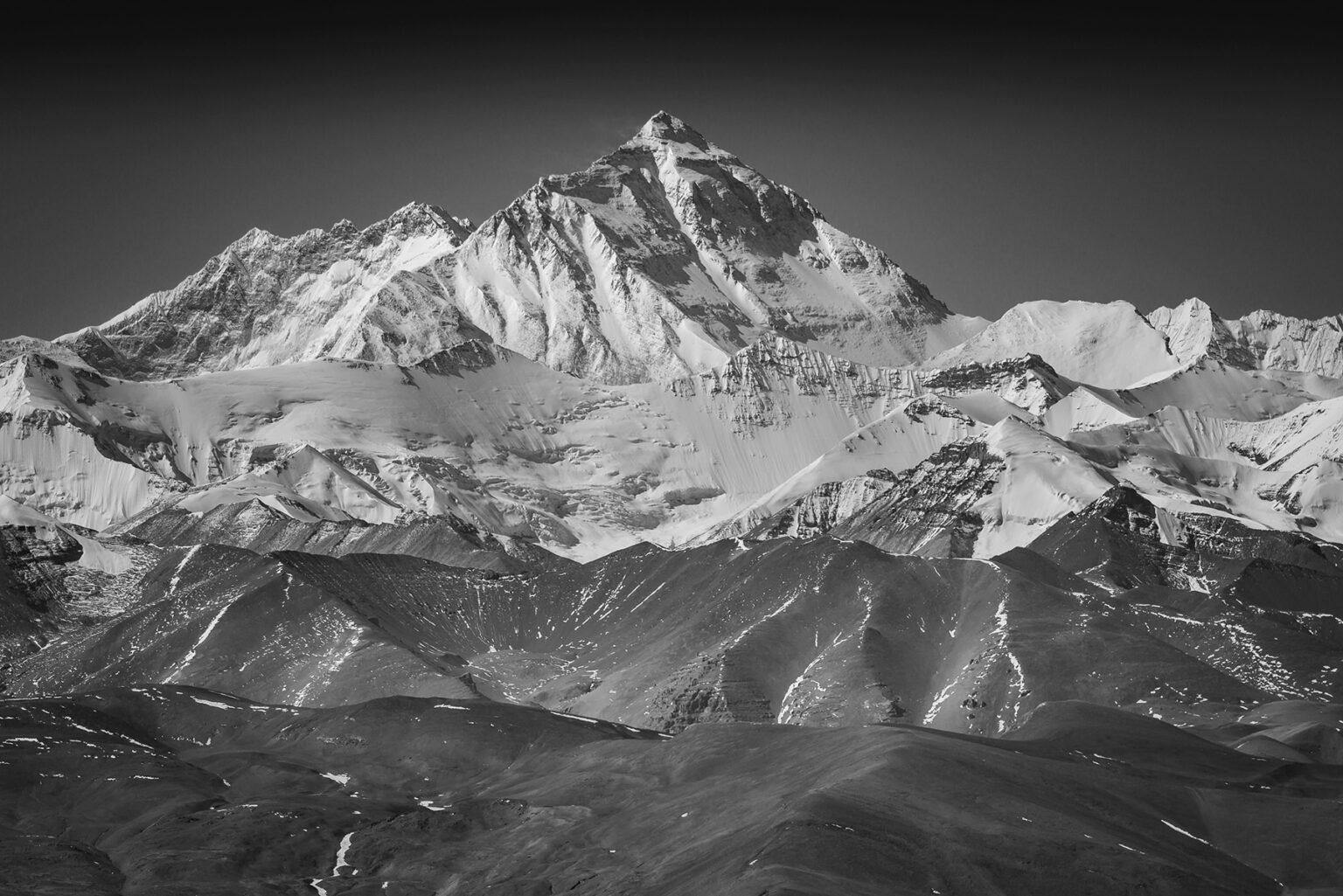Mount Everest, the world’s tallest mountain, conjures images of adventure, glaciers, superhuman mountain guides and Sherpas, and majestic views. But how long does it take to climb Mount Everest, and how much fitness is needed to undertake an expedition to Mount Everest? We’ve researched for you and outlined what it takes to climb Mount Everest and how important logistics and physiology are to reach the summit.
Climbing Mount Everest is a major undertaking, not just from a pure mountaineering standpoint. The logistics required, remoteness of the location, mountaineering-specific training, and physical requirements for acclimation all contribute to a lengthy expedition. While climbing a mountain such as Denali (with a peak of 20,310ft) might take around 3-4 weeks, the average expedition to summit Mount Everest takes two months.

A typical Mount Everest expedition takes about two months.
YOUR DAYS ON THE MOUNTAIN
The path to the summit of Mount Everest via the popular South Col route is divided into a series of camps, all sitting at increasing elevations. After acclimating, it takes approximately 5-6 days to reach the summit and descend, but after reaching the base camp, the two-month timer for a summit bid starts. After reaching the South Base Camp, climbers spend the next several weeks ascending and descending between the camps to properly acclimate for the final summit push and move food and climbing gear between camps. To reach Camp I, it usually takes climbers 2-4 hours. Camp I sits at ~20,000ft (6100m), a significant jump in elevation from the already high altitude base camps, and requires navigating the Khumbu Icefall (the foot of the Khumbu glacier) to reach.
Reaching Camp II from Camp I typically takes climbers 6-8 hours but highly depends on fitness level. Camp II sits at ~21,000ft (6400m), representing the beginning of the final acclimatization process for making a summit bid. Food and equipment will continue to be moved from Camp I to Camp II as you prepare to push toward Camp III at 23,000ft (6800m). Camp III is the final point at which you can continue acclimatizing to the altitude since Camp IIII sits in the “death zone” (26,000ft or 8000m). This altitude earned its ominous name because, at this elevation, the partial pressure of oxygen in the atmosphere is so low that life becomes unsustainable. Most climbers must use bottled oxygen simply to survive. Reaching Camp III likely takes 2-3 hours of climbing.
From Camp III, the final summit push through the death zone to 29,029ft begins. A summit push likely takes 4-8 hours, given the extreme altitude.
A major obstacle between Camp III and the summit was removed in 2015 when an earthquake removed the Hillary Step – a vertical rock face near the summit. However, this remains the most physically difficult phase of the climb. After reaching the summit, you will spend a few minutes savoring the views and your achievement before making your way rapidly down and out of the death zone. While it is possible to descend to base camp from the summit in a single push, most Everest expeditions will spend another night at Camp II or III before finishing the descent the next day. The descent is widely considered the most dangerous part of the climb, and even good weather and perfect conditions aren’t a guarantee of a safe return to base camp. The physical toll the climb has taken so far, at this point nearly two months of effort and high altitude life, combined with a prolonged period in the death zone at extremely low temperatures, can cause climbers to become highly confused or delirious and unable to reach shelter.
After returning to the lower camps, the chances of returning safely to base camp increase dramatically, and while you are still operating in a high-altitude environment, you have spent a lot of time preparing to be active in the death zone, so you are well acclimatized to the altitude between Camp I and base camp.
It’s clear that to ascend Mount Everest safely, climbers have to stick to a lengthy and well-structured process of moving up and down the mountain. Below, we’ll get into what’s happening on the individual level that makes this important.
WHY DOES IT TAKE SO LONG TO CLIMB MOUNT EVEREST?
The main reason climbing Everest takes so long for most people is acclimatization, the process of adapting to high altitude, low oxygen environments.
To put things in perspective, the South Base Camp in Nepal sits at an elevation of 17,598ft (5,364m), and the North Base Camp on the Tibetan side sits at 16,900ft (5,150m). The vast majority of the world’s population lives well below what is considered, physiologically, moderate elevation (5000-8000ft, 1524-2438m), and for many people going up to 11,000ft – 14,000ft (3352-4267m) can be a physically challenging experience.

High on Mount Everest’s North Ridge
Scientifically, there is a lot we still don’t know about the effects of altitude on the human body and when or why altitude sickness strikes. However, we do know that there’s a correlation between aerobic capacity and the ability to perform at higher altitudes. Below, we’ll dive into how Everest is climbed and what this means for your body.
PHYSIOLOGY AT ALTITUDE
As we move into higher and higher elevations, the partial pressure of oxygen in the atmosphere gets lower. As a result, there is less oxygen for our bodies and muscles to utilize. As the hemoglobin in our blood becomes less saturated with oxygen, we see a shift in the balance of the Fick equation, which is used to determine VO2.
Our ability to use available atmospheric oxygen is measured through VO2. The equation to determine VO2 is cardiac output (Heart Rate x Stroke Volume) multiplied by the Avo2 Difference, which is the difference in the partial pressure of O2 in arterial and venous blood. You’ve probably heard of VO2 max, the maximal point of an individual’s ability to use oxygen, and is often used as a marker of possible endurance capacity, but submaximal VO2 plays a role in altitude. As the partial pressure of oxygen in the atmosphere decreases, we move closer and closer to our VO2 max.
Without supplemental oxygen, most people sitting on the summit of Everest will feel like they’ve been asked to run a 100-yard dash as fast as they can without stopping because there is simply too little oxygen available for use.
Properly acclimating to such an extreme environment takes time, especially if you live at or close to sea level. Additionally, you will not keep your hard-won adaptations once you leave an environment such as high altitude. A few groups, one being the Sherpa people of Nepal, are both born with and keep high altitude adaptations when brought to sea level. This is a product of many generations living at high altitudes and cannot be perfectly replicated via acclimatization. While spending time in the mountains and at higher altitudes will serve you extremely well on Mount Everest, it’s important to remember that you cannot pre-acclimate to the elevation levels, and you will never fully adapt to the extreme environment. This doesn’t mean you must be genetically gifted to climb Mount Everest, but you must understand what is being asked of you and your body in this unique environment.
ACCLIMATIZATION AND ISSUES WITH PROLONGED ALTITUDE EXPOSURE
We know that steady acclimatization and ascending no more than a few thousand feet per day are good preventative measures, and bouncing between the camps makes even more sense. Failure to properly acclimate can lead to two main forms of acute altitude sickness, sometimes also called “mountain sickness”, which are High Altitude Pulmonary Edema (HAPE) and High Altitude Cerebral Edema (HACE). While the mechanisms are slightly different, both are due to a low-oxygen environment that causes lung or brain swelling. In both cases, there is only one effective cure: descent. Acute altitude sickness can affect people very differently.
A sedentary person might not experience any symptoms, while a trained marathon runner could struggle to spend a night above 13,000ft.

Mount Everest's Summit
Physical fitness is not viewed as a preventative measure, while slow and steady acclimatization is considered the only real method of managing the possible onset of altitude sickness.
HAPE can occur at roughly 8,200ft (2,500m), while HACE generally occurs at a higher altitude of 13,000ft (4,000m). There are records of cases occurring below these elevations as well, but it’s quite rare.
What we can take away from the science of altitude sickness, as it relates to Mount Everest, is that simply hiking to base camp puts you well above the required altitude to see an onset of symptoms.
WHAT HAPPENS WHEN WE ACCLIMATIZE?
The two main responses in our bodies when reaching higher altitudes are:
- Hyperventilation (breathing more rapidly)
- Increased blood flow
First and foremost, our bodies care about survival, and at altitude, they will focus on getting more O2 into the blood, then that blood more quickly to organs and muscles. As you spend more time at a high altitude, you will see deeper changes to your physiology, which your Everest expedition guides are trying to develop before making a summit bid. A corresponding decrease in blood plasma and increase in hemoglobin, increased mitochondrial density, more aerobic enzymes, and a higher number of red blood cells are a few of these deeper adaptations, all of which are based on getting O2 in and using it more effectively.
CONCLUSION
Putting it all together, between what’s happening on the mountain and inside your body, the answer to the question “how long does it take to climb Mount Everest” can vary, but it can’t be rushed. The two months required to climb Mount Everest, including the trek to base camp, acclimation, and 5-6 days spent making the final summit push, should all be aided by a pre-existing high fitness level.
The more time you can devote to adapting to this extreme environment, the better you are likely to feel and perform, but no one can just muscle themselves to the summit. Proper preparation, including developing a strong aerobic base, muscular endurance, and maximal strength, represents the foundations of any successful summit bid. Given the time it takes to climb Mount Everest, choosing the proper training plan with the appropriate lead time is crucial.
You may also like:
Climbing Mount Everest in Two Weeks Door to Door
Mount Everest without Oxygen: Reaching the Highest Point of My Life

